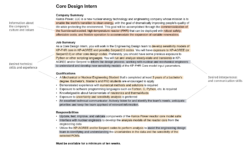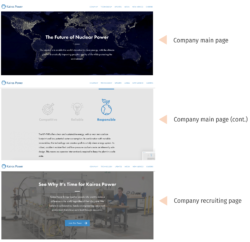“Please attach your cover letter here.” This prompt can be intimidating whether it’s for your first internship or a senior position. Cover letters are your way to introduce yourself (and your resume) to an employer, start a conversation, and hopefully get an interview! For some positions, a cover letter may be a formality; for others, it will be used to gauge how you’ll fit in. This article details the key elements of a cover letter and how to tailor it effectively. A good cover letter alone won’t get you a job, but it can help you get your foot in the door.
1. Before you start
The overall goal of a cover letter is simple: get you selected for the next round of the hiring process. Therefore, you need to make it very clear that you understand what the reviewer is looking for, and that you are a qualified match.
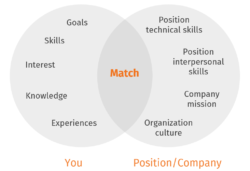
1.1. Why this position? Why you?
Research the organization. Go through the employer’s website and reach out to people you know within the organization to learn more about what they are looking for in new employees. Understand their values and long-term vision. Culture fit may be particularly important when applying at small organizations.
Review the job posting. Job descriptions are intentionally written to focus on the key words the employer wants in applicants. Make special note of expected knowledge and background, specific skills, stated goals and values of the organization, and the tone and formality of the job posting.
The strongest applicants will have the largest and clearest overlap between the position and their background. Maximize your chance for getting an interview by highlighting this match in your cover letter!
1.2. Analyze your audience
Your audience can seem unclear, especially if you’re submitting an application through an online portal. It’s best to assume that both technical and non‑technical audiences will be reviewing your cover letter. To strike the right balance between ambiguous wording and excessive jargon, try to match the job description itself. Include key words from the posting, echo values listed on the company website, and show that you can speak the same “language.”
See an example of how to analyze a job description.
2. Key elements of a cover letter
Although cover letters should be carefully tailored, they also follow a typical structure. Some have separates sections for Interest and Qualifications, while others weave these two together. As long as the letter ties all these elements together in a coherent fashion, you will be fine (see examples).
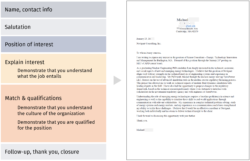
2.1. Stating the position
Begin by identifying the specific position you’re applying for, and include the posting number if there is one. If the organization is hiring for several positions at once, they’ll know how to direct your application.
Example 1: “I am writing to express interest in the Future Leaders Programme Downstream Technology position (Req. ID: 12345AB).”
Example 2: “I am pleased to submit an application for the position of Research Software Engineer at the IBM Thomas J. Watson Research Center.”
2.2. Explaining your interest
Next, briefly describe why you’re applying to the company or why you’re interested in the position. Don’t exaggerate (e.g., “It was my childhood dream to perform database management for a mid-tier technology company”) but you can honestly describe how your interests, background, and goals align with position and company. This is where the prework you did will become helpful.
Example: “I believe that this project has the opportunity to both reduce the time associated with safety analyses and licensing, and to reduce the cost associated with design and construction of the SPARC and ARC reactors.”
2.3. Highlighting your qualified match
This is the bulk of your letter. In 1–3 main points, demonstrate that you are a match by highlighting relevant technical and interpersonal skills. In other words, do not summarize your resume! As you describe yourself as a strong candidate, try to provide concrete evidence (“showing”) rather than stating (“telling”) that you have the qualifications needed. If you have meaningful connections with the organization, you should mention them here as well.

2.4. Facilitating follow-up
Wrap up by reiterating your interest in the position, then indicate in one sentence your desire to continue the conversation. Unless the letter is sent within an email, be sure to include your contact information.
Example 1: “I look forward to the opportunity of speaking with you further about this postdoctoral position.”
Example 2: “Should you have any questions regarding this letter or my resume, please do not hesitate to contact me by phone at [phone number] or by email at [email address]. I thank you for your time and consideration.”
3. Cover letters for special situations
Occasionally, something in your application (or your application itself!) may seem surprising to the reviewers. Anticipate questions they may have and address them in your cover letter. Below are three common scenarios where this might be the case.
3.1. Applying for jobs outside your field
If you’re not a “typical” applicant or are applying for a job outside of your field, you will need to describe why the position makes sense for your specific career path or interests. Provide ample evidence that your background and experience fit the position requirements. Don’t dwell on where you don’t fit the typical applicant profile; rather, highlight transferable skills and matching values.
Example: “Teaching has been the common thread that ties together my science background and my current roles in the nonprofit world. […] Whether I taught thermodynamics at X College, coached underserved students through the Posse Foundation, or tutored survivors of domestic violence, my motivation has always been to instill a sense of empowerment in all my students.”
3.2. Explaining resume gaps or extenuating circumstances
It is not uncommon to have a gap in your resume. And for applications that include your academic transcript, you may wish to describe circumstances that possibly led to lower grades one semester. You do not need to discuss these things in your cover letter, but this is an acceptable place if you feel that additional context would better frame your application.
When describing these topics, don’t dwell on what went wrong. Instead, briefly explain the issue and then (if appropriate) mention what you did to overcome it and how it shaped you as an applicant. Remember to keep this section concise and professional!
3.3. Answering general calls for applications
For some companies, the Job Opportunities webpage only reads, “Interested applicants should submit their cover letter and resume to…” without referring to a specific position. In these cases, networking with current employees at the company is the most effective method to learn more about their openings. If you’re not able to do so, you can submit a “cold” cover letter to inquire about potential opportunities.
The goal of this type of cover letter is to show your interest in the company, demonstrate that you understand what they care about, and describe how you could match possible positions. If successful, you will be considered for available positions now or in the future.
4. Quick tips
- Don’t spend hours trying to track down the exact name of the person who will be reviewing your cover letter and application. If you can’t find out for sure, know that a simple “Dear Future Talent Program Coordinator” or “Dear Manager” will not sink your candidacy.
- Proofread. Proofread. And Proofread again. You are being evaluated so a single typo (especially in people’s names!) will suggest a lack of attention to detail and set you off on the wrong foot.
- Not all jobs put a lot of weight on the cover letter, but those that especially value leadership and communication skills will use your letter as a demonstration of those skills. Use your real voice to let them see who you are.
- Check out resources from MIT Career Advising and Professional Development (CAPD).
5. Authentic examples
5.1. Analyzing a job description
For every position of interest, carefully go through the job description line by line and highlight key words about what the organization is about and what qualifications they are looking for. Make sure to also click around the company website to learn more about their value system. This will help you not only write a more compelling cover letter but also engage in meaningful conversations if you are selected for an interview!
5.2. Examples of cover letters
- Non-NSE cover letter samples from CAPD
- Authentic examples from in and around MIT NSE:
 |
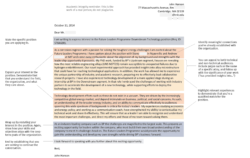 |
5.3. Excerpts
Authentic samples from in and around MIT NSE (do not plagiarize):
| Explaining your interest in an internship that involves the review of nuclear startup funding proposals | “I’m very interested in the future of nuclear technology and getting new nuclear plants built in the next 20 years. I have also seen, however, that overly optimistic or misguided claims from developers or proponents of nuclear technology can muddy the waters for potential investors and customers. The brief internship description of performing technical due diligence and technology evaluation was particularly interesting because would be an opportunity to dig into the technical details of emerging nuclear technologies and help decision makers evaluate which projects have promise and which projects are actually too good to be true.” |
| Matching interpersonal skills | “In addition, my prior work has allowed me to experience the unique partnership of industry and academic research, preparing me to effectively lead collaborative research projects. I have also experienced technology development at a more applied stage during an internship at [this company] in the Downstream segment. In that role I embraced the challenges of working with industry partners to accelerate the development of a new technology, while supporting efforts to deploy the technology in the field.” |
| Wrap up | “My great scientific interest moving forward in my career is to continue to advance and develop methods for in situ materials characterization as dynamic evolution is occurring. By coupling the capabilities of the many tools for such types of characterization at [this lab], I believe that a much more complete picture of microstructure evolution and performance degradation may be captured in a huge variety of materials systems, specifically including nanostructured materials. From my time spent at [this lab] thus far, I know I enjoy the working environment at the lab in general and the research center in particular. I look forward to the opportunity of speaking with you further about this postdoctoral position.” |
To get started or receive feedback on your cover letter, make an appointment with us. We’d love to help!

